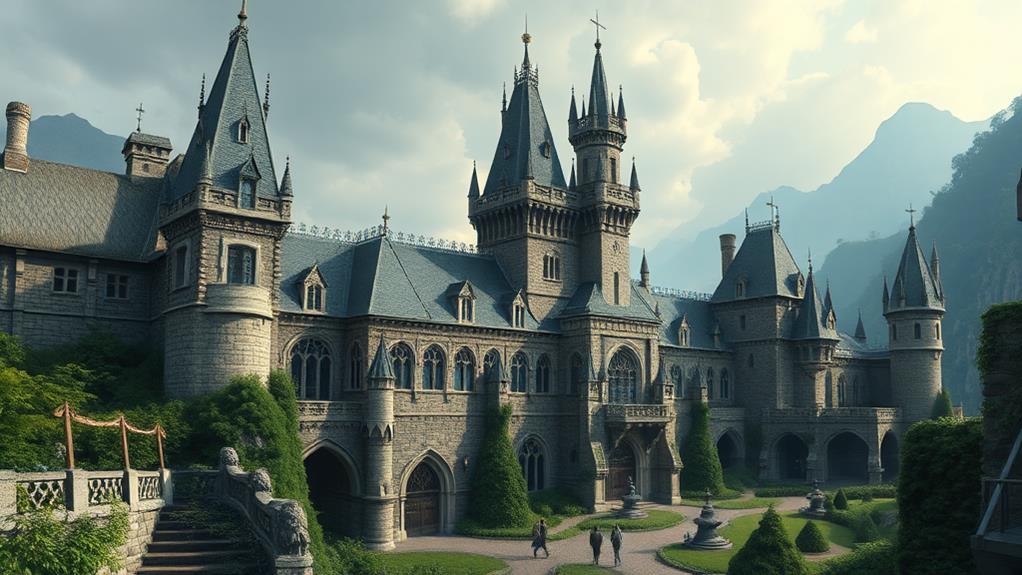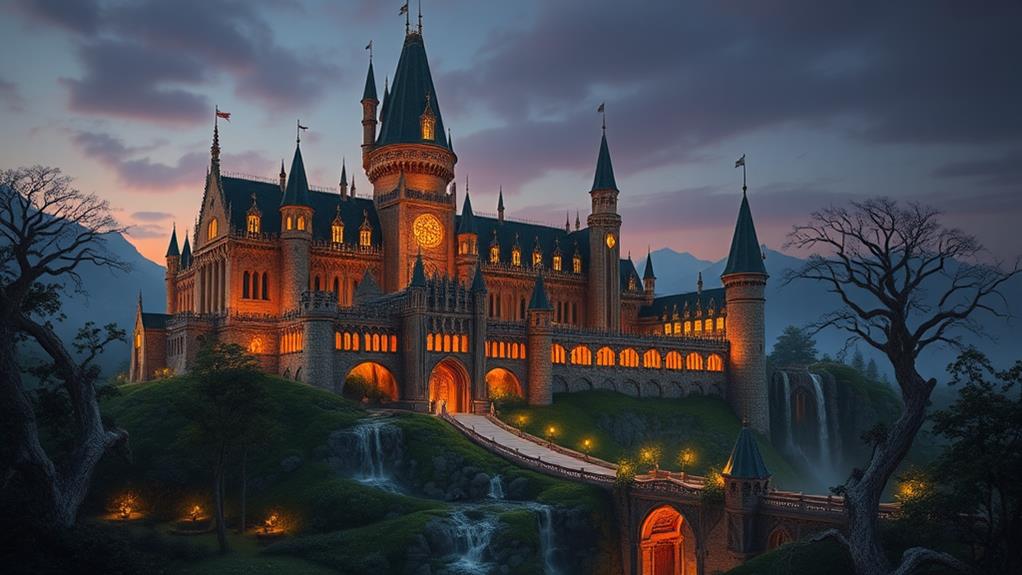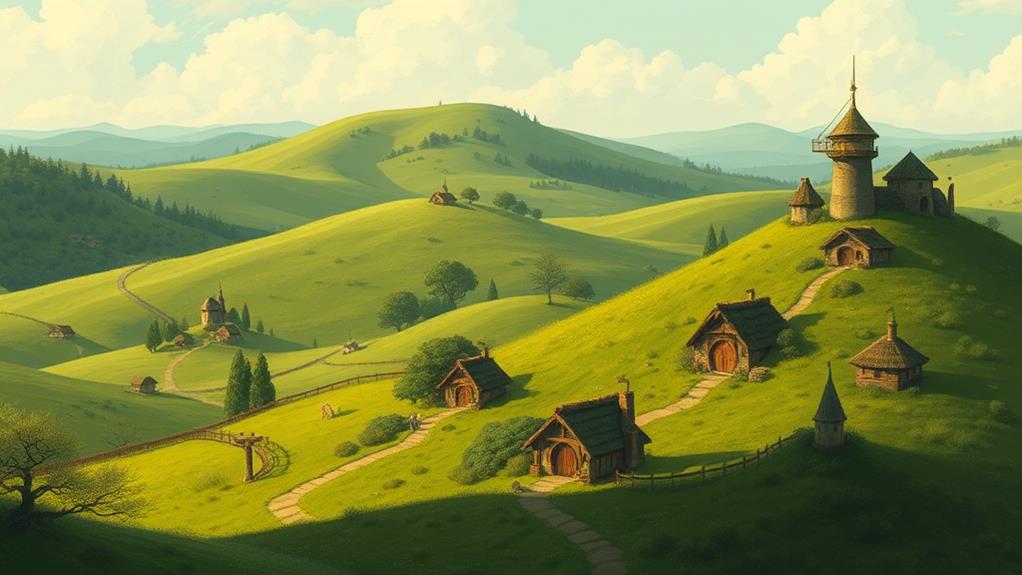
You'll find Middle Earth's castle architecture incredibly varied and deeply tied to each culture. Elven castles blend seamlessly with nature, using marble, crystal, and delicate woodwork. Dwarven strongholds feature massive gates, hidden traps, and rich decorations. Gondorian structures, like Minas Tirith, use towering white stone and strategic hilltop locations. Rohan's fortresses, built from wood and stone, prioritize practicality. The Shire relies on natural barriers and camouflaged hobbit homes for defense. Mordor citadels exude menace with dark stone walls and iron spikes. If you're curious about these fantastic styles, there's much more to uncover about their unique details and stories.
Elven Elegance

Elven Elegance captures the ethereal beauty and sophisticated craftsmanship that define elven castle architecture. When you first lay eyes on an elven castle, you'll notice its seamless integration with the natural landscape. Elves build their structures to complement the environment, using materials like marble and crystal that shimmer in the light. Towers often spiral upward, resembling ancient trees, while seamless arches mimic the graceful curves of nature.
Walking inside, you'll be struck by the open, airy design. Natural light floods the rooms through expansive windows, casting intricate patterns on the floors. Elven architects prioritize both aesthetics and function, creating spaces that are as practical as they are beautiful. You'll find finely carved woodwork, delicate tapestries, and flowing water features that add to the tranquil atmosphere.
Details matter in elven design. Every column, staircase, and door handle is a work of art. You might even find living elements like vines and flowers woven into the architecture, symbolizing the elves' deep connection to nature. Fundamentally, when you step into an elven castle, you're entering a harmonious blend of art, nature, and magic, all meticulously crafted to inspire awe and serenity.
Dwarven Strongholds
While elven castles float gracefully in the treetops, dwarven strongholds root themselves firmly in the mountains. When you think of dwarven architecture, imagine vast halls carved directly into the rock, illuminated by the glow of precious gems. These strongholds aren't just visually stunning; they're also marvels of engineering and craftsmanship.
Dwarves take pride in their stonework, and their fortresses reflect this dedication. You'll notice several distinctive features:
- Massive Gates: These are often intricately designed and serve as both a grand entrance and a formidable defense.
- Labyrinthine Layouts: Dwarven halls are a maze of corridors and chambers, designed to confuse invaders.
- Hidden Traps: Secret mechanisms and traps are strategically placed to deter enemies.
- Rich Decorations: Walls adorned with runes and reliefs tell the stories of their ancestors and victories.
Dwarven strongholds aren't just about defense; they also emphasize community and tradition. You'll find great halls for feasting, forges where master smiths create legendary weapons, and archives preserving their rich history. These fortresses are an embodiment of dwarven resilience and their deep connection to the earth.
Gondorian Grandeur

How does one capture the essence of Gondorian grandeur? Picture towering white stone walls, carved meticulously and soaring high above the landscape. You'll see how every detail exudes elegance and strength. The architecture blends both function and artistry, with structures like Minas Tirith standing as prime examples. These fortresses are not just military strongholds; they're also symbols of Gondor's enduring legacy and sophisticated culture.
When you walk through a Gondorian castle, you'll notice the extensive use of arches and buttresses, which provide both support and aesthetic appeal. The grand halls often feature vaulted ceilings and intricate carvings that tell tales of ancient history and valor. Windows are typically narrow, designed for defense but also allowing just enough light to create a serene ambiance inside.
Don't overlook the strategic placement of these castles. Often built atop hills or mountains, they offer panoramic views of the surrounding lands, providing both a psychological and tactical advantage. The use of natural rock formations in their construction further enhances their resilience.
In essence, Gondorian architecture captures a blend of majesty and practicality, making every castle a fortress of both beauty and defense.
Rohan Fortresses
The fortresses of Rohan, known for their rugged and practical design, stand in stark contrast to the grandeur of Gondorian architecture. You'll notice that Rohan's strongholds, like Helm's Deep and Edoras, are built with functionality and defense as their main priorities. These structures reflect the hardiness and resilience of the Rohirrim people, designed to withstand sieges and harsh weather conditions.
Rohan fortresses are characterized by their:
- Wooden Palisades: High wooden walls often reinforced with earthworks to provide a first line of defense.
- Stone Keeps: Central stone buildings that offer a final refuge if outer defenses are breached.
- Strategic Locations: Positioned on hilltops or nestled in valleys to maximize defensive advantages.
- Simple Interiors: Practical and straightforward, focusing on utility rather than luxury.
You'll find that Rohan's architecture is deeply influenced by their culture and environment. The emphasis on wood and stone showcases their connection to the land and their need for sturdy, reliable structures. Unlike the ornate and towering castles of Gondor, Rohan's fortresses are more about substance over style, ensuring they're prepared for any threat that comes their way.
The Shire's Defenses

Rohan's formidable fortresses are a stark contrast to the subtle and almost hidden defenses of the Shire. You won't find towering walls or imposing gates here. Instead, the Shire relies on natural barriers and the Hobbits' intimate knowledge of their land. Rolling hills and dense woods create natural deterrents, making it difficult for outsiders to navigate.
Hobbit homes, or smials, are built into hillsides, their entrances camouflaged by greenery. This architectural style isn't just charming; it's strategic. These burrow-like dwellings blend seamlessly with the landscape, making them hard to detect from a distance. Paths meander through the Shire, often leading to dead ends or looping back on themselves, confusing any potential invaders.
The community's tight-knit nature also serves as a defense. Everyone knows each other, so any stranger is immediately noticed and questioned. The Shire's defenses might not be overtly military, but they're effective. Their primary strategy is to avoid attention and confrontation altogether, relying on the land and their own close bonds to keep them safe. So, while the Shire may seem idyllic and peaceful, it's far from defenseless.
Mordor Citadels
Mordor's citadels, with their dark, foreboding architecture, embody the very essence of Sauron's malevolent power. These strongholds, such as Barad-dûr and the Black Gate, are designed to instill fear and assert dominance. You'll notice the use of sharp, jagged edges and towering spires that pierce the sky, symbolizing Sauron's unyielding control.
When you examine these structures, several characteristics stand out:
- Imposing Heights: Towers rise to intimidating heights, casting long shadows that remind all of Sauron's far-reaching influence.
- Reinforced Walls: Thick, dark stone walls are designed to withstand siege and assault, making them nearly impregnable.
- Sinister Aesthetics: Iron spikes, dark iron gates, and grotesque sculptures contribute to a menacing appearance.
- Strategic Placement: Citadels are often situated in locations that offer tactical advantages, such as overlooking vital passes or borders.
These architectural choices aren't just for show; they serve practical purposes in warfare and control. The citadels' designs make them formidable bastions that are difficult to infiltrate or attack. When you think of Mordor, these grim fortifications are central to its image, reflecting the dark will of their master.
At a Glance
In Middle Earth, the elegance of Elven castles contrasts sharply with the rugged strength of Dwarven strongholds. Gondorian grandeur stands tall against the humble yet sturdy fortresses of Rohan. Even the Shire's quaint defenses offer a sense of community that starkly opposes the foreboding citadels of Mordor. Each architectural style tells a unique story, reflecting the diverse cultures and histories that coexist in this rich, fantastical world. You'll find that every stone and archway has its own tale to tell.






